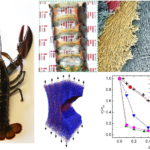Paper, Natural hydrogel in American lobster: A soft armor with high toughness and strength
Abstract: Homarus americanus, known as American lobster, is fully covered by its exoskeleton composed of rigid cuticles and soft membranes. These soft membranes are mainly located at the joints and abdomen to connect the rigid cuticles and greatly contribute to the agility of the lobster in swimming and preying. Herein, we show that the soft membrane from American lobster is a natural hydrogel (90% water) with exceptionally high toughness (up to 24.98 MJ/m3) and strength (up to 23.36 MPa), and is very insensitive to cracks. By combining experimental measurements and large-scale computational modeling, we demonstrate that the unique multilayered structure in this membrane, achieved through the ordered arrangement of chitin fibers, plays a crucial role in dissipating energy during rupture and making this membrane tough and damage tolerant. The knowledge learned from the soft membrane of natural lobsters sheds light on designing synthetic soft, yet strong and tough materials for reliable usage under extreme mechanical conditions, including a flexible armor that can provide full-body protection without sacrificing limb mobility.
Learn about our two Decals!
 Click here to find out more about our Fall Bioinspired Design Decal and our Spring Bioinspired Design in Action Decal – ALL MAJORS are welcome.
Click here to find out more about our Fall Bioinspired Design Decal and our Spring Bioinspired Design in Action Decal – ALL MAJORS are welcome.Berkeley BioDesign Community
 Click here to learn about the BioD: Bio-Inspired Design @ Berkeley student organization or here to signup for more info.
Click here to learn about the BioD: Bio-Inspired Design @ Berkeley student organization or here to signup for more info.Search
Student Login




I imagine that the neurological circuits underlying these processes are governed by both 2d spacing maps with their brains as…
to reduce the impact of car accidents, it may be possible to study the force diverting physics of cockroaches to…
you see this type of head-bobbing stability in many avian creatures related to pigeons like chickens. the head ability to…
not like they taught horses how to run! this is an example of convergent evolution where both sea creatures and…
The brain functions in a similar way with neuronal connections. our brains are able to utilize the multiplicity of connections…